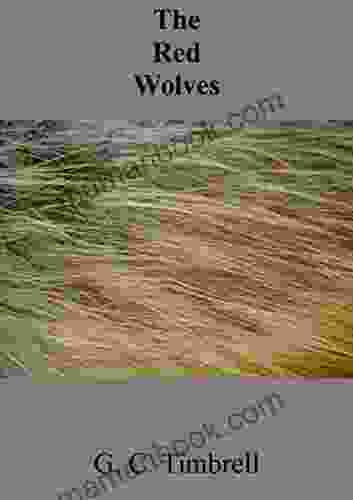The Enigmatic Red Wolves of Timbrell: A Tale of Conservation and Resilience


In the secluded wilderness of the Timbrell Wildlife Preserve, a remarkable species roams: the red wolf (Canis rufus). Once widespread across the southeastern United States, the red wolf dwindled to near extinction in the 1960s due to habitat loss, hunting, and persecution. Thanks to dedicated conservation efforts, a small population has been reintroduced to Timbrell, serving as a beacon of hope for this endangered species.
5 out of 5
| Language | : | English |
| File size | : | 495 KB |
| Text-to-Speech | : | Enabled |
| Screen Reader | : | Supported |
| Enhanced typesetting | : | Enabled |
| Word Wise | : | Enabled |
| Print length | : | 16 pages |
| Lending | : | Enabled |
Physical Characteristics
Red wolves are medium-sized canids, slightly smaller than their gray wolf counterparts. They have a distinctive reddish-brown coat that provides camouflage in the deciduous forests they inhabit. Their ears are pointed and erect, and their eyes are typically amber or yellow. Males weigh between 25 and 45 pounds, while females weigh between 20 and 35 pounds.
Behavior and Social Structure
Red wolves are highly social animals that live in cohesive packs typically consisting of a dominant breeding pair, their offspring, and possibly a few subordinate adults. Packs establish territories that they vigorously defend against intruders. They communicate through a complex system of vocalizations, body language, and scent marking.
Within the pack, the breeding pair forms a strong bond and shares responsibilities for raising their pups. Pups are born in dens and remain dependent on their parents for food and protection during their early months. As they grow older, they gradually learn hunting and social skills from older pack members.
Habitat and Diet
Red wolves occupy a variety of habitats within the Timbrell Wildlife Preserve, including bottomland hardwood forests, swamps, and upland pine forests. They are opportunistic predators and their diet primarily consists of white-tailed deer, wild hogs, rabbits, and rodents. They also scavenge on carrion and occasionally supplement their diet with fruits and vegetables.
Conservation Status and Re
By the 1960s, red wolves had been extirpated from their former range due to a combination of habitat loss, hunting, and persecution. In 1987, a re program was initiated to restore the species to its historic home in the southeastern United States. The Timbrell Wildlife Preserve became one of several release sites for captive-bred red wolves.
The reintroduced population has faced challenges, including habitat fragmentation, poaching, and vehicle collisions. However, conservation organizations and wildlife managers have implemented various measures to protect and support the wolves. Habitat corridors have been established to connect isolated populations, public awareness campaigns have been conducted to reduce human-wolf conflicts, and strict enforcement of anti-poaching laws has been implemented.
Ecological Importance
Red wolves play a vital role in maintaining the ecological balance of the Timbrell Wildlife Preserve. As apex predators, they regulate deer and hog populations, which in turn benefits a wide range of other species. Their hunting behavior reduces the risk of overgrazing and promotes forest regeneration. Additionally, their presence helps maintain genetic diversity within deer populations, preventing genetic bottlenecks.
Challenges and Future Prospects
Despite the remarkable progress made in restoring the red wolf population in Timbrell, challenges remain. Habitat fragmentation, human-wolf interactions, and climate change pose ongoing threats to the species' survival.
Conservationists are working diligently to address these challenges. They continue to monitor and manage wolf populations, collaborate with landowners to secure habitat, and educate the public about the importance of red wolf conservation. Additionally, research is being conducted to identify and mitigate threats, such as disease transmission and human-wolf conflicts.
By combining science-based conservation efforts with public support, the future of the red wolves in Timbrell looks promising. These enigmatic predators not only serve as a testament to the resilience of endangered species but also contribute significantly to the ecological health of their unique and precious ecosystem.
The red wolves of Timbrell Wildlife Preserve represent a triumph of conservation. Through the dedication and hard work of countless individuals and organizations, these once critically endangered animals have been given a second chance at survival. As we witness their remarkable journey, we are reminded of the intricate web of life and the importance of protecting and preserving our natural heritage.
5 out of 5
| Language | : | English |
| File size | : | 495 KB |
| Text-to-Speech | : | Enabled |
| Screen Reader | : | Supported |
| Enhanced typesetting | : | Enabled |
| Word Wise | : | Enabled |
| Print length | : | 16 pages |
| Lending | : | Enabled |
Do you want to contribute by writing guest posts on this blog?
Please contact us and send us a resume of previous articles that you have written.
 Top Book
Top Book Novel
Novel Fiction
Fiction Nonfiction
Nonfiction Literature
Literature Paperback
Paperback Hardcover
Hardcover E-book
E-book Audiobook
Audiobook Bestseller
Bestseller Classic
Classic Mystery
Mystery Thriller
Thriller Romance
Romance Fantasy
Fantasy Science Fiction
Science Fiction Biography
Biography Memoir
Memoir Autobiography
Autobiography Poetry
Poetry Drama
Drama Historical Fiction
Historical Fiction Self-help
Self-help Young Adult
Young Adult Childrens Books
Childrens Books Graphic Novel
Graphic Novel Anthology
Anthology Series
Series Encyclopedia
Encyclopedia Reference
Reference Guidebook
Guidebook Textbook
Textbook Workbook
Workbook Journal
Journal Diary
Diary Manuscript
Manuscript Folio
Folio Pulp Fiction
Pulp Fiction Short Stories
Short Stories Fairy Tales
Fairy Tales Fables
Fables Mythology
Mythology Philosophy
Philosophy Religion
Religion Spirituality
Spirituality Essays
Essays Critique
Critique Commentary
Commentary Glossary
Glossary Bibliography
Bibliography Index
Index Table of Contents
Table of Contents Preface
Preface Introduction
Introduction Foreword
Foreword Afterword
Afterword Appendices
Appendices Annotations
Annotations Footnotes
Footnotes Epilogue
Epilogue Prologue
Prologue Kimberly Diede
Kimberly Diede Kelly Jensen
Kelly Jensen Liam Naden
Liam Naden Albert Pike
Albert Pike Hilda Ochoa Brillembourg
Hilda Ochoa Brillembourg Keisuke Itagaki
Keisuke Itagaki James K Lyon
James K Lyon Lami Kamikaze
Lami Kamikaze Emma Slate
Emma Slate Jeanne St James
Jeanne St James Amanda M Lee
Amanda M Lee Justo May Correa
Justo May Correa Reader S Aid
Reader S Aid Luchrisa Valentine
Luchrisa Valentine Hvac Training 101
Hvac Training 101 Aoife Abbey
Aoife Abbey Barbi Cox
Barbi Cox Erin Gleeson
Erin Gleeson Rebecca Keele
Rebecca Keele Lisa Bilyeu
Lisa Bilyeu
Light bulbAdvertise smarter! Our strategic ad space ensures maximum exposure. Reserve your spot today!
 Jeffery BellFollow ·9.8k
Jeffery BellFollow ·9.8k Herman MelvilleFollow ·17.1k
Herman MelvilleFollow ·17.1k Cortez ReedFollow ·19.5k
Cortez ReedFollow ·19.5k Gregory WoodsFollow ·10.7k
Gregory WoodsFollow ·10.7k Dylan HayesFollow ·13.9k
Dylan HayesFollow ·13.9k Cade SimmonsFollow ·19k
Cade SimmonsFollow ·19k Earl WilliamsFollow ·7.1k
Earl WilliamsFollow ·7.1k Easton PowellFollow ·17.8k
Easton PowellFollow ·17.8k

 Ernest Powell
Ernest PowellBenefits of Corporal Punishment: A Review of the...
Corporal punishment is a form of physical...

 Bobby Howard
Bobby HowardThe Development and Significance of African American...
African American...

 Guy Powell
Guy PowellDown Girl: The Logic of Misogyny - A Comprehensive...
In her groundbreaking work,...

 Forrest Blair
Forrest BlairThe Bikini Changing Room: A Micro Mini Romance
In the heart of...
5 out of 5
| Language | : | English |
| File size | : | 495 KB |
| Text-to-Speech | : | Enabled |
| Screen Reader | : | Supported |
| Enhanced typesetting | : | Enabled |
| Word Wise | : | Enabled |
| Print length | : | 16 pages |
| Lending | : | Enabled |
















